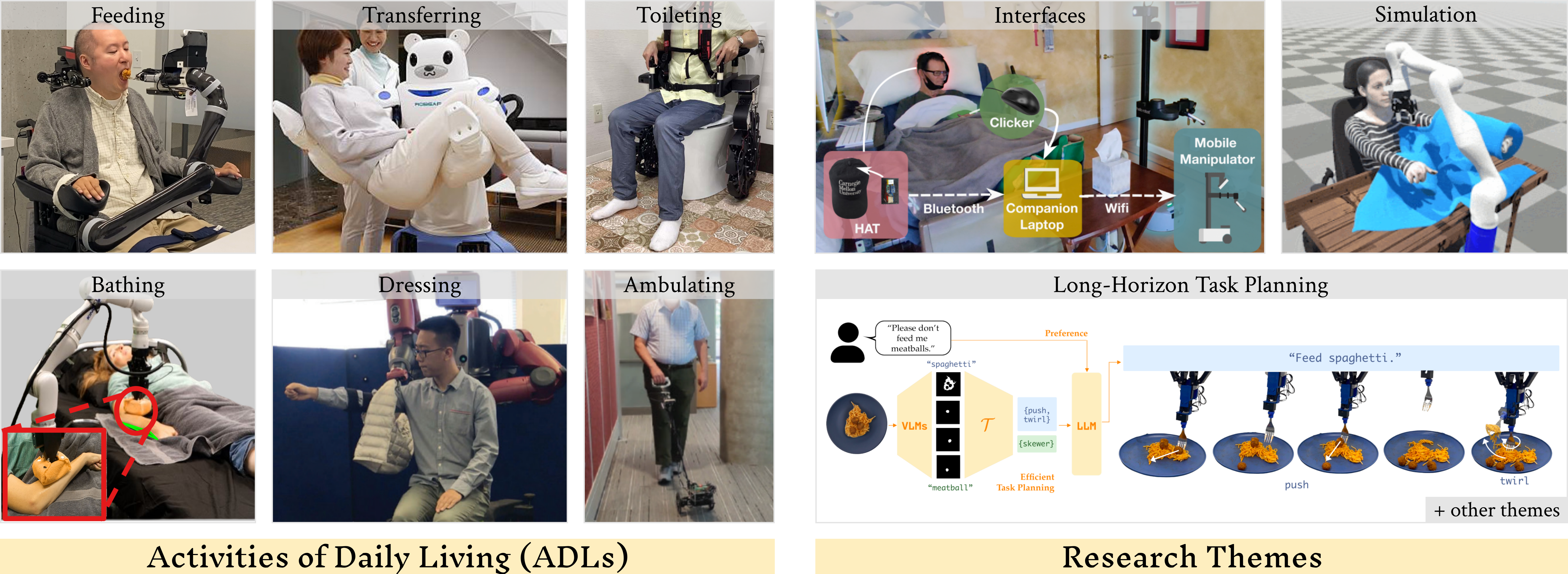Enhancing Independence with Physical Caregiving Robots Workshop

The World Health Organization reports that nearly 190 million individuals worldwide have motor impairments [
1
Americans with disabilities: 2014.
Danielle M. Taylor.
US Census Bureau, 2018.
], requiring assistance with Activities of Daily Living (ADLs) such as eating, bathing, dressing, etc. [
2
Activities of daily living.
Peter F. Edemekong, Deb Bomgaars, Sukesh Sukumaran, Shoshana B. Levy.
StatPearls Publishing LLC, 2019.
]. This need for support impacts their mental health, intensifying feelings of dependence and helplessness [
3
Feel the Bite: Robot-Assisted Inside-Mouth Bite Transfer using Robust Mouth Perception and Physical Interaction-Aware Control.
Rajat Kumar Jenamani, Daniel Stabile, Ziang Liu, Abrar Anwar, Katherine Dimitropoulou, Tapomayukh Bhattacharjee.
ACM/IEEE International Conference on Human-Robot Interaction, 2024.
,
4
Design principles for robot-assisted feeding in social contexts.
Amal Nanavati, Patricia Alves-Oliveira, Tyler Schrenk, Ethan K. Gordon, Maya Cakmak, Siddhartha S. Srinivasa.
ACM/IEEE International Conference on Human-Robot Interaction, 2023.
]. Moreover, the shortage of caregivers places a heavy physical workload on those available [
5
Caregiver and clinician shortages in an aging nation.
Kevin C. Fleming, Jonathan M. Evans, Darryl S. Chutka.
Mayo Clinic Proceedings, 2003.
] and pushes care recipients toward institutionalized living centers, which can constrain personal freedoms and heighten feelings of isolation [
6
Risk factors of institutionalization in an elderly disabled population.
Ulrike Kliebsch, Til Stürmer, Harald Siebert, Hermann Brenner.
The European Journal of Public Health, 1998.
]. With the global shift towards an aging society, these urgent challenges are set to worsen [
7
Caregiving in an ageing world.
Jonathan Perry and others.
United Nations, 2022.
]. This workshop focuses on enabling robots to assist with physical caregiving [
8
Physically assistive robots: A systematic review of mobile and manipulator robots that physically assist people with disabilities.
Amal Nanavati, Vinitha Ranganeni, Maya Cakmak.
Annual Review of Control, Robotics, and Autonomous Systems, 2023.
]—a pivotal step towards a sustainable care model that enhances the quality of life of care recipients [
9
The role of assistive robotics in the lives of persons with disability.
Steven W. Brose et al.
American Journal of Physical Medicine & Rehabilitation, 2010.
] and alleviates caregiver workload [
10
Is more autonomy always better? Exploring preferences of users with mobility impairments in robot-assisted feeding.
Tapomayukh Bhattacharjee et al.
ACM/IEEE International Conference on Human-Robot Interaction, 2020.
,
3
Feel the Bite: Robot-Assisted Inside-Mouth Bite Transfer using Robust Mouth Perception and Physical Interaction-Aware Control.
Rajat Kumar Jenamani et al.
ACM/IEEE International Conference on Human-Robot Interaction, 2024.
].
Research in this area has been extensive. In the 1960s, researchers developed a robotic arm that could move a user’s paralyzed arm, allowing him to complete tasks like feeding himself [
11
Electronic detours of broken nerve paths.
Luiji Vodovnik, William D. McLeod.
Electronics, 1965.
]. The 1970s and 80s saw the development of a guide robot for people who are blind [
12
Study of guide dog (seeing eye) robot (I).
Susumu Tachi et al.
Bulletin of Mechanical Engineering Laboratory (Japan), 1978.
], a table-mounted robot-assisted feeding system that was clinically evaluated in homes [
13
Feasibility Study For Assistive Feeder.
Guy N. Phillips.
Southwest Research Institute, 1987.
], and multi-purpose robotic worktables that allowed users to feed themselves, pick up a phone, and brush their teeth [
14
An overview of the development of Handy 1, a rehabilitation robot to assist the severely disabled.
Mike Topping.
Artificial Life and Robotics, 2000.
,
15
Early clinical evaluation of a robot arm/worktable system for spinal-cord-injured persons.
W. Seamone, G. Schmeisser.
Journal of Rehabilitation Research and Development, 1985.
]. As research has progressed, some tools have been translated into commercial products, including table-mounted robot feeding systems [
16
Assistive Dining Technology 1970 through 2005.
Mealtime Partners, Inc., 2005.
,
17
New Obi Robotic Dining Device a breakthrough for people living with physical challenges.
Dar Artman et al.
Multivu, PR Newswire, 2016.
] and wheelchair-mounted robot arms [
18
Canadian robotic arm pushes the boundaries for people with impaired mobility.
National Research Council Canada, 2015.
]. There are also recent efforts to commercialize guide robots for people who are blind [
19
Chinese robot ‘guide dog’ aims to improve independence for visually impaired.
Casey Hall, Xihao Jiang.
Reuters, 2024.
,
20
Glidance unveils new design, opens pilot program for users.
Mike Oitzman.
The Robot Report, 2024.
]. However, considerable research challenges still remain. A recent survey on physically assistive robotics shows a surge of interest over the last decade [
8
Physically assistive robots: A systematic review of mobile and manipulator robots that physically assist people with disabilities.
Amal Nanavati et al.
Annual Review of Control, Robotics, and Autonomous Systems, 2023.
], and just the last two years of HRI conferences have seen multiple papers, workshops, and keynotes in this area [
4
Design principles for robot-assisted feeding in social contexts.
Amal Nanavati et al.
ACM/IEEE International Conference on Human-Robot Interaction, 2023.
,
21
Exploring Levels of Control for a Navigation Assistant for Blind Travelers.
Vinitha Ranganeni et al.
ACM/IEEE International Conference on Human-Robot Interaction, 2023.
,
22
Interaction techniques with a navigation robot for the visually impaired.
Chieko Asakawa.
ACM/IEEE International Conference on Human-Robot Interaction, 2023.
,
3
Feel the Bite: Robot-Assisted Inside-Mouth Bite Transfer using Robust Mouth Perception and Physical Interaction-Aware Control.
Rajat Kumar Jenamani et al.
ACM/IEEE International Conference on Human-Robot Interaction, 2024.
,
23
Independence in the Home: A Wearable Interface for a Person with Quadriplegia to Teleoperate a Mobile Manipulator.
Akhil Padmanabha et al.
ACM/IEEE International Conference on Human-Robot Interaction, 2024.
,
24
RABBIT: A robot-assisted bed bathing system with multimodal perception and integrated compliance.
Rishabh Madan et al.
ACM/IEEE International Conference on Human-Robot Interaction, 2024.
].
With this workshop, we aim to continue this momentum by bringing together a diverse group of researchers, end-users, caregivers, and occupational therapists to discuss existing research on physical caregiving robots, identify gaps, foster collaborations, and chart future research directions.
Highlights
Engagement from All Stakeholder Communities: Our workshop will feature insights from five care recipients, one caregiver, two occupational therapists, and numerous robotics researchers from both academia and industry. This diverse participation will provide critical perspectives on the real-world impact of assistive technologies in caregiving and the state-of-the-art in robotics.
Community Newsletter: This workshop will launch a mailing list for care recipients, caregivers, occupational therapists, and roboticists interested in physical caregiving robots. Responding to past concerns about intermittent engagement, we’ll provide regular updates on advancements and trends in physical caregiving robotics. The newsletter will also serve as a platform for recruiting participants for future studies.
Breakout Sessions to Synthesize Learnings Across ADLs and Research Themes: To promote meaningful discussions, we will organize breakout sessions focused on two key areas: specific Activities of Daily Living (ADLs) and critical research themes such as task planning, personalization, system design, and user interfaces. These discussions will be followed by a synthesis session, bringing together the insights gained across both dimensions to further the development of physical caregiving robots.
Discussion Topics
- Long-term deployments of physical caregiving robots
- Generalization of physical caregiving robots across users, robots, environments, and tasks
- Interfaces for individuals with mobility limitations
- Simulation and sim-to-real transfer for physical caregiving robots
- Foundation models for physical caregiving robots
- Long-horizon task planning for physical caregiving robots
- Anomaly detection in physical caregiving robots
- Wearables for physical caregiving robots
- Multimodal sensing for physical caregiving robots
- Societal and policy considerations for physical caregiving robots
Schedule
| Time (AEDT, GMT+11) | Event |
|---|---|
| 9:00 am - 9:10 am | Welcome & Workshop Overview |
| 9:10 am - 9:50 am | Keynote: Robots For Humanity - Henry and Jane Evans, Hello Robot (Vy Nguyen & Vinitha Ranganeni) |
| 9:50 am - 10:45 am | Panel 1: Opportunities & Challenges for Caregiving Robots: Voices from the Frontlines of Care Care Recipients: Kathleen Hooks, Owen Kent, Henry Evans, Benjamin Howe, Jonathan Ko Caregivers: Jane Evans |
| 10:45 am - 11:10 am | Coffee Break |
| 11:10 am - 12:00 pm | Panel 2: Deploying Physical Caregiving Robots Academia: Maya Cakmak (UW) Occupational Therapists: Katherine Dimitropolou (Columbia), Vy Nguyen (Hello Robot) |
| 12:00 pm - 1:00 pm | Lunch |
| 1:00 pm - 2:00 pm | Panel 3: Technical Challenges in Physical Caregiving Robots Academia: Tapomayukh Bhattacharjee (Cornell), Chung Hyuk Park (GWU) Industry: Aaron Edsinger (CEO, Hello Robot), Jose Barreiros (Scientist, Toyota Research Institute) |
| 2:00 pm - 3:00 pm | Lightning Talks |
| 3:00 pm - 3:30 pm | Coffee Break |
| 3:30 pm - 4:30 pm | Breakout discussions, split by ADLs and research themes |
| 4:30 pm - 5:00 pm | Discussion, Closing, and Call to Action |





